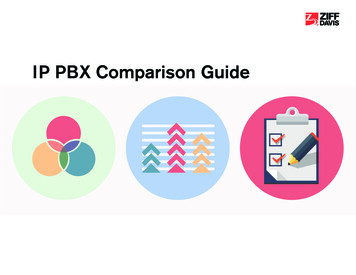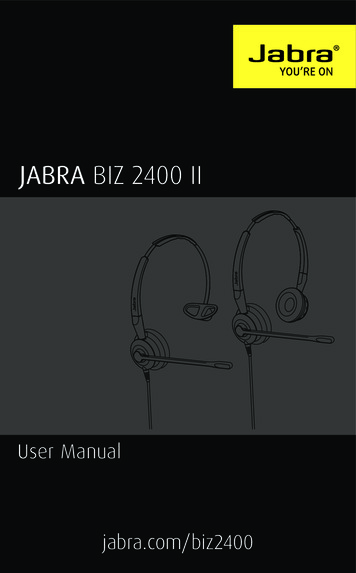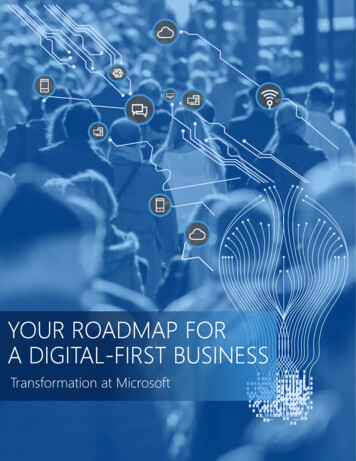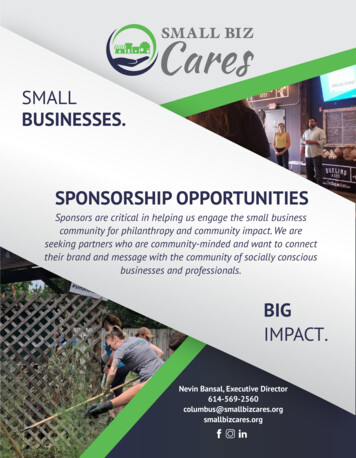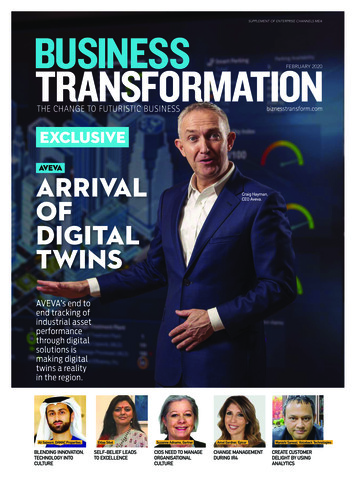
Transcription
SUPPLEMENT OF ENTERPRISE CHANNELS MEABUSINESSTRANSFORMATIONFEBRUARY 2020THE CHANGE TO FUTURISTIC FDIGITALTWINSCraig Hayman,CEO Aveva.AVEVA’s end toend tracking ofindustrial assetperformancethrough digitalsolutions ismaking digitaltwins a realityin the region.Ali Sajwani, DAMAC Properties.BLENDING INNOVATION,TECHNOLOGY INTOCULTUREEktaa SibalSELF-BELIEF LEADSTO EXCELLENCESuzanne Adnams, GartnerCIOS NEED TO MANAGEORGANISATIONALCULTUREAmel Gardner, EpicorCHANGE MANAGEMENTDURING IR4Manishi Sanwal, Voiceback Technologies.CREATE CUSTOMERDELIGHT BY USINGANALYTICS
EDITOR’S PREFACEBUSINESSTRANSFORMATIONTHE CHANGE TO FUTURISTIC BUSINESSMANAGING DIRECTORTushar Sahootushar@gecmediagroup.comGREEN ENERGY, MOBILITYDISRUPTING TRANSPORTATIONA publication licensed byInternational Media Production Zone, Dubai, UAE@Copyright 2018 Accent Infomedia.All rights reserved.Beasts of burden were once humankind’sprinciple mode of transport. There was onlyinnovation around the carriage used fortransport. Then came along the engine withvarious forms of propulsion and there wasinnovation around the engine and the carriage.Today, innovation still continues around theengine and the carriage, but the focus has moved to the passenger anddelivery as a service. All of this has been made possible because the dataaround passenger as a service has become more integrated. Urbanisationand connectivity is the key to commercial success if your business isinside an urban location.With the emphasis on green energy and sustainability, citizens oftomorrow will choose their mode of transport inside an urban location,that is the most emission free, that is the most renewable and the mostsustainable, amongst other reasons. They may share transport or hiretransport or use a rapid and mass transit system. The organisers oftransport are increasingly moving away from a capital investment modeof entry to an integrated as a service model, offering urban travelers, anintegrated choice of transport that is achievable and managed througha mobile application. Sometimes they even plan to deliver the service toyou even before you know you will be needing it.Alstom a global leader in energy solutions and rolling stock hascompletely transformed its portfolio of solutions due to these highlytransformative disruptors. These include the growing need for anintegrated form of urban transport, the changing nature of the customer,and the expectation to focus on the quality and value of the service, andfinally sustainability. Turn to our market section to learn more abouthow Alstom is adapting to these global and regional challenges.AVEVA concluded its regional event for customers and channel partnersin Abu Dhabi at the end of January. There were eye openers andtakeaways at this event. Digital twins probably mean different thingsfor different industries. AVEVA’s specialisation is in engineering andprocess industries. If you are able to build the 3D rendering of everycomponent of an engineering or industrial project and further can tracktheir operational data parametres and further integrate them into avisualisation layer, then you are pretty much on track and have reachedthe digital twin stage as delivered by AVEVA for its customers today.The digital twin is not one thing. It is the ability to look at digital dataand navigate through the digital data about an asset in interestingways: commented Craig Hayman, CEO AVEVA, during an exclusivediscussion at the event. Turn the pages to read much more on thissubject. Also catch what our experts have to say in this issue: EktaaSibal; Suzanne Adnams, Gartner; Philip van der Wilt, ServiceNow; AmelGardner, Epicor; Jacob Chacko, Aruba HPE; Manishi Sanwal, VoicebackTechnologies.Happy reading, happy transformation.While the publishers have made every effort toensure the accuracy of all information in thismagazine, they will not be held responsible for anyerrors therein.Arun Shankararun@gecmediagroup.comEDITORArun Shankararun@gecmediagroup.comCEORonak Samantarayronak@gecmediagroup.comGLOBAL HEAD, CONTENT AND STRATEGICALLIANCESAnushree Dixitanushree@gecmediagroup.comGROUP SALES HEADRicha Sricha@gecmediagroup.comEVENTS EXECUTIVEShriya Nairshriya@gecmdiagroup.comEVENTS EXECUTIVELhodith Annann@gecmediagroup.comSALES AND ADVERTISINGRonak Samantarayronak@gecmediagroup.comPh: 971 555 120 490PRODUCTION, CIRCULATION, SUBSCRIPTIONSinfo@gecmediagroup.comUAE223 DMC 9 Dubai Media City, DubaiPO Box 500653, Ph: 971 4 368 8523USA31 Foxtail Lan, Monmouth JunctionNJ 08852, Ph: 1 732 794 5918Printed byAl Ghurair Printing & Publishing LLC.Masafi Compound, Satwa, PO Box: 5613,Dubai, UAEPublished byAccent Infomedia MEA FZ-LLC223 DMC 9 Dubai Media City, DubaiPO Box 500653, Ph: 971 4 368 8523biznesstransform.com3
Global Community forTechnology leaders
CONTENTSFEBRUARY 202006 OPINIONSelf-belief08leads to excellenceOPINIONWhy CIOs need to manageorganisational culture as well10 OPINIONWhy CIOs and business headsneed to be a team12INDUSTRY COMMENTSChange management cannot beshrugged off during IR415INDUSTRY COMMENTS3 steps to align networksand digital transformation28COVER FEATURETARGETING LARGE SCALEINDUSTRIES WITH DIGITAL SOLUTIONS1824USE CASES33MARKET OUTLOOKBuilding Oracle’s second-generationpublic cloudDisruption in urban transportation20INDUSTRY COMMENTSHow to create customer delight byusing analyticsCHAMPIONS40 TRANSFORMATIONBlending innovation andEVENTSWorkforce transformation:Dell, Ingram Micro, Intel round table44RESEARCH46LOOKING GLASStechnology into culture5
OPINIONSELF-BELIEFLEADS TO EXCELLENCEMeditation helps to build the right mindset that helps create a sense of self-belief and athigher level a feeling of excellence in our lives, explains Ektaa Sibal.Ektaa Sibal is an InternationalInner Self, TransformationSpecialist and an InternationalMeditation Expert, Speaker and aGifted Energy Healer with inbornintuitive abilities.When you make excellenceas a part of your life, youstart leading a productiveand successful life, have happy andfulfilling relationships and mostimportantly have inner satisfaction.Achieving excellence isnot limited to becoming perfectin the work you do, but it is muchbeyond that. Excellence is in theprocess and not outcome. It is a6continuous effort to improve yourperformance consistently so that youcan enhance every dimension of yourlife such as family, work, education,relationships, finance.Self-belief is paramount to successthat leads to excellence. When youhave self-belief then there is nothingthat can stop you from achievingwhat you would have aimed for.Every time you achieve something– no matter big or small - givea pat on your back. Appreciatingyour achievements creates positiveimpression in your mind that leadsto increasing your confidence whichinherently builds your self- belief.A very important pillar ofexcellence is creating the rightmindset. If the mind is not in theright place, nothing can be achievedand when the mind is strong andpositively driven – you can achieveeverything and anything.Meditation is a powerful tool togain mastery over yourself, to bemotivated and most importantlycreate a mindset that offers strengthand power. Meditation is beingvouched as a very effective techniqueby many global leaders who use thisfor sharpening their saw.I recommend investing at least tenminutes a day towards meditationto manifest excellence. In fact,meditation has been proven to workwonders by increasing the cognitiveperformance of any individualpracticing it on a regular basis. Thatis why global leaders such asRay Dalio, Oprah Winfrey, lateSteve Jobs, Russell Brand, EllenDeGeneres imbibe meditation as apart of their routine.Fear is a major roadblock thatcan stop you from achievingexcellence in life. This fear can bestemming from any dimensionof your life but it’s importantto work on your fears and findsolutions rather than focus on theproblem.Do not be afraid of tryingnew ideas that may help you inachieving your aim. Be on thelookout of all those possibilities asthose can be fundamental buildingblocks in achieving success.When you are constantlyworking on excellence, chancesare that you will come acrossmany situations that are newto you – adaptability is the keyto manage those situations.Believing that change is the onlysolution and making it your friendis the best solution for all thosechallenging situations that youmay face.For instance, changing yourplans- while it is important tohave a strong planning structure,it is also important to not becomeoverly attached to your plansadapt yourself to sometimesimprovise your plans or evendrop it if it does not seem to beworking.biznesstransform.com
www.btxshow.comand C-suite Awards 2020April-May 2020DIGITAL TRANSFORMATION FOR C-SUITEAND BUSINESSSAUDI ANAANALYTICS, ARTIFICIALINTELLIGENCE, AUTOMATIONCLOUD, ERP, SUPPLY CHAINMANAGEMENTCYBERSECURITY, DATAINDUSTRIAL AND DIGITAL, INTERNETOF THINGS, SELF LEARNING SYSTEMSPEOPLE, SKILLS, CULTUREBROUGHT BYOFFICIAL MEDIA PARTNERS
OPINIONWHY CIOS NEED TO MANAGEORGANISATIONAL CULTURE AS WELLLike any senior executive CIOs need to be sensitive to the human side of employees in the ITorganisation, explains Suzanne Adnams, Gartner.SUZANNE ADNAMS,Vice President Analyst,Gartner.At Imperial College London,the CIO was transitioning histeam from waterfall to agilemethodology when he discovered aserious workplace culture problem.Employee engagement was low.He was having trouble getting hisstaff members to own their inclusiongoals. Top-down messaging andbias education efforts were not doingenough. Clearly, success requiredmore than emails from leadership8and mandatory training modules —the business needed broad, deep andsustained behavioral change.When traditional ways ofinfluencing company culture arenot enough, what can a CIO do toinspire sustained behavioral change?The first step is understanding whatculture means.By 2021, CIOs will be asresponsible for leading workplaceculture as their peers in HR. But todo that, CIOs must understand howthese values, mindsets and practicesintersect. Leaders have directinfluence over how these three facetsaffect behaviors to shape the culture.They must also put a tactical strategyinto place so that positive behaviorsare identified, modeled, encouragedand rewarded.Organisational values must beconsistent with organisational goals,and must be reflected in leaders’daily decisions and behaviors.Missing or inconsistent leadershipmodeling of values underminesworkplace culture and can harmbroader strategic objectives.Organisations that have notestablished consistent and strategyaligned values cannot expectto see consistent and positiveworkplace behaviors. CIOs lookingto influence culture should be firstconcerned with the values of the ITorganisation. If these group valuesare not clearly understood, thenpersonal values will become the basisof individual decisions and actions.With only 13% of HR leadersreporting that employees believestrongly in an organisation’sdesired culture, it is fair tosay that most CIOs do notreally understand what theiremployees are thinking. Andalthough it is true that mostCIOs will not have time to getto know everyone in their ITorganisation personally, theyare still responsible for theculture within that organisation.Therefore, CIOs should modelaccepting, inclusive behavior atall times.Creating a work environmentthat promotes personalacceptance and inclusion helpsstaff feel safe enough to sharetheir mindsets and be open witheach other, Adnams says.Involving all stakeholdersusing an open source approachis one tactic to ensureauthenticity and to promoteengagement in culture shaping.Sharing lessons from failuresand modeling self-awarenessare some of the many criticalbehaviors you can adopt to makeyourself more approachable.Changing how organisationsoperate has a much greaterpositive impact on aligning theworkforce to the organisation’sdesired culture. Any behavior,habit or routine will continueto persist as long as there issomething in the environmentthat rewards and reinforces thatcontinued action.biznesstransform.com
Some waitfor Thursdayto end!Some waitfor Sundayto Begin!www.fitsmea.comUNVEILING THE FUTURE AT#FITSMEA20'Address Dubai MarinaMarch 16, 2020HAPPY COMPANIES CREATE HAPPY EMPLOYEESNOMINATECATEGORIESSMBs (0-150 EMPLOYEES)ENTERPRISES (151-5000 EMPLOYEES)LAST DATE FOR NOMINATION: 18TH FEB, 2020BROUGHT BYOFFICIAL MEDIA PARTNERS
OPINIONWHY CIOS AND BUSINESS HEADSNEED TO BE A TEAMFor CIOs to successfully lead digital transformation, business heads need to be comfortablepeers with them, writes Philip van der Wilt at ServiceNow.PHILIP VAN DER WILT,SVP and GM EMEA,ServiceNow.High-performing CIOs arechanging the way they interactwith their C-level peers,talking about business value ratherthan just technology. They arealigning with other leaders to unlockthe benefits of digital transformationacross the organisation.CIOs are also increasinglybecoming the orchestrators of thedigital dream team, a concept. Ledby the CIO, these are the new, key10decision-makers across finance, HR,customer experience, operations,and IT—and other businessfunctions—that are driving thedigital transformation agenda.This all sounds well and good, butwhy have we only moved this far?Based on recent conversations, itis clear that this comes down to fourimportant points that need closeattention if budgets, stakeholders,and technology are to fully align andexecute on this transformation.Somewhat ironically, thechallenge is not technology itself.Technology also will not make thingshappen—people will. But peopleare often resistant to change and inmany cases risk-averse.CEOs are driving the digitalagenda from the top, but if theyvoice any concerns or do not lendtheir support, it is unlikely anyinitiatives will succeed. Equally, itis important to build wider supportby coaching and involving all keyfunctions, such as HR, marketing,and CX.Also, good communication skillscoupled with speaking the languageof other functions helps increaseunderstanding and buy-in. Thisincludes references to specificmetrics or KPIs that, for example,HR, finance, or CX leaders use intheir business areas. Inclusion is key.It almost feels natural that theCIO should be the one the CEO putsin charge of digital transformation.Indeed, in my conversations withour customers and partners, thefeedback I most often hear, is thatit is the CIOs and CDOs who arespearheading such initiatives.But the CIO’s mandate shouldnot be taken for granted. Securingownership of cross-functionalchange is extremely important andthis also means acceptance fromC-level peers to make decisions inthe interests of the organisation.It is particularly importantwhen we consider that 62% ofbudgets invested to support digitaltransformation initiatives comefrom outside of IT, according toIDC.Big projects often fail, but byimplementing change in smallsteps—or sprints, if you like—youcan maintain a sense of controlledevolution. A step-by-stepapproach will also keep the CEO onboard, who is unlikely to put theircareer on the line for the sakeof a big bang, wide-scale digitaltransformation.You also come across projectsand business cases that areinadequate, in the sense, they areeither too detailed or too vagueand are primarily based on gutfeeling. Striking the right balancebetween detail and high-levelpriorities will ensure businesscases can be used as dynamic,live documents in any part of thebusiness.biznesstransform.com
biznesstransform.com11
INDUSTRY COMMENTCHANGE MANAGEMENT CANNOTBE SHRUGGED OFF DURING IR4Management styles in manufacturing may downplay the need for change managementand reduce risk taking, highlights Amel Gardner at Epicor.AMEL GARDNER,Regional Vice President, MiddleEast, Africa and India, Epicor.The success of digitaltransformation is not justabout investing in the righttechnology. As with any large-scaleproject—from a change in workinglocation to a company merger—the impact on the people involvedneeds to be a key considerationwhen putting a strategy andimplementation plan in place.However, in a bid to keep upwith the latest technology trends,manufacturers could be shootingthemselves in the foot by notaddressing the change managementand cultural aspects from the outset.In fact, recent research hasfound that only a quarter 26%of businesses consider changemanagement strategies to be animportant part of the move towardsIndustry 4.0 and the connectedenterprise. This suggests that a largeproportion of manufacturers are notputting steps in place to managethe impact of such a change oncorporate culture, which could affectthe ultimate success of any digitaltransformation project.Despite pressure on businessesand individuals to remain at thecutting edge, no one wants to bean early adopter and get it wrong.A recent report from Deloitte intoIndustry 4.0 readiness found thateven in today’s technology-drivenworld, senior executives are notas prepared as they think theyare to reap rewards from digitaltransformation.Faced with an ever-increasingarray of new technologies, leadersacknowledged they have too manyoptions from which to choose and,in some cases, they lack the strategicvision to help guide their efforts.Organisational influences alsochallenge leaders as they seekto navigate Industry 4.0. Manyleaders reported their companiesdo not follow clearly defineddecision-making processes, andorganisational silos limit their abilityto develop and share knowledge todetermine effective strategies.To make Industry 4.0 a success,no matter how big or small thechange, manufacturers need to putkey measures in place to manage thetransition. This includes undertakingthe necessary groundwork to ensurethat whatever technology businessesinvest in, they can get the best outof it.#1 BE REALISTICDespite digital transformation beingvery much an industry buzzword,manufacturers do not need to takeeverything on at once. Assess whatneeds to be automated and why.If something is working and theprocess efficient, it might not needchanging just yet. The key to gettingit right is to prioritise adoptionrather than change for changes sake.A phased approach will be beneficialfor everyone in the long term.#2 ON BOARD STAKEHOLDERSFollowing an assessment ofpriorities, manufacturers need tomap and plan out what needs tohappen next—from procurementto implementation and beyond.This ensures that all stakeholdersfrom every department affected areclear about what is happening, whyand when. Only then can everyoneinvolved be prepared and plan forthe roll-out.
INDUSTRY COMMENTJUMPING ON THE BANDWAGON OFNEW TECHNOLOGY TOO QUICKLYCOULD BE DETRIMENTAL IN THELONG-TERM#3 KEEP TALKINGCommunication at every stageis essential—particularly beforeimplementation. Users need to feelthey are part of the process andcan raise any concerns or questionsbefore a new way of working isthrust upon them. Taking timeto address any potential issues atthe start of a project will ensureusers are bought into the process,understand what is expected of themand avoid any pitfalls further downthe line.#4 TRAINING AND SUPPORTKEY TAKEAWAYS No one wants to be an earlyadopter and get it wrong. Senior executives are not asprepared to reap rewardsfrom digital transformation. Assess what needs to beautomated and why. Only 26% of businessesconsider changemanagement strategies to bean important part. Key to getting it right is toprioritise adoption ratherthan change. Stakeholders from everydepartment affectedare clear about what ishappening, why and when.biznesstransform.comFor efficiency and productivity tobe realised, users need to have goodunderstanding of how technologyimpacts their working practices. Thiscan only be done through trainingand support. While this could be anoverwhelming prospect, breakingit down into bite-sized, digestiblesessions will be invaluable ratherthan overloading people with toomuch information from the outset.It is also worth considering thateveryone learns in different ways,so whilst an online demo or trainingmanual might be right for oneperson, someone else might prefermore visual tools like a video or astep-by-step animated guide, forexample.#5 TAKE YOUR TIMEThe choice of new technologies canbe overwhelming and daunting foreven a seasoned professional. Neverlose sight of why you are investing intechnology and keep your businessobjectives in mind—what yourcompetitor is doing might not bethe right approach for you.Jumping on the bandwagonor adopting new technology tooquickly could be detrimental inthe long-term, if the process isnot well thought through or fit forpurpose.#6 REGULAR REVIEWSWhile following steps one tofive will ensure the business hasthe best chance of successfullyadopting new technology, it willall be in vain if you miss out stepsix. The hard work does not stopwhen you reach go-live—in fact,that is only just the start of thedigital transformation process.For a project to be a truesuccess, any technologyinvestment needs to be reviewedand assessed regularly. Is it beingused to its full potential? Are thereany gaps in training? What morecould the business get from it?What is the data showing? Canit be analysed to improve futurebusiness growth?Only by following these six stepswill the manufacturing industrybring the whole business alongfor the digital transformation rideand ensure that Industry 4.0 isa success. Having a clear changemanagement and implementationstrategy will enable businessesto realise the full value oftechnology, whilst guaranteeingstrong ROI and user acceptance.13
6TH EDITIONwww.fitsmea.comHONORING THE BEST AT#CATALYSTSMEA20#LeaderXHonoring the bestAddress Dubai MarinaMarch 16, 2020BROUGHT BYOFFICIAL MEDIA PARTNERS
INDUSTRY COMMENT3 STEPS TO ALIGN NETWORKSAND DIGITAL TRANSFORMATIONThe network is the backbone for an organization’s digital transformation and JacobChacko at Aruba HPE advises learning from three global examples.#1 DEFINITION OF WORKPLACEJACOB CHACKO,Regional Business Head Middle East,Saudi and South Africa, Aruba HPE.With every organisation ata different stage in theirtransformation journey,and technologies frequently movingfaster than they can keep up with, itcan be easy to lose sight of what theyare trying to achieve in the long termin a rush to just get on with thingsand deliver immediate and tangiblechanges.So, what networking lessons canbe shared from some recent digitalworkplace transformation projectsthat might come in useful for thoseorganisations who might need tostop and pause?biznesstransform.comWith today’s need for increasedmobility, the demand for networksupport both inside and outsidethe workplace, be that an office,school, shop or hospital, is intense.However, though most organisationsare already thinking about remoteworking requirements whenplanning their digital workplacetransformations, many are stillfailing to consider all the coverageblack spots within the building itself,and in doing so, are missing a trick.A recently completed wirelessnetwork upgrade was for TheFinnish Institute of OccupationalHealth, FIOH, which is anorganisation that specialises inwellbeing at work. With such aremit, digital working is inevitablya major focus, and to be able to bestadvise its clients, the organisationhas set itself the mandate of trulyliving digital working, not justresearching it.When the time came to refurbishits headquarters in Helsinki,FIOH decided it was the perfectopportunity to rethink its currentnetwork provisioning, and install asolution that would enable completemobility for its staff, wherever theywork. Importantly, FIOH did not justmean the places where employeesmight be stationary, in rooms, atdesks or in shared lounge areas, butthose they would potentially movethrough while still on calls or usingtheir digital applications.Thinking holistically about thejourneys that its staff took aroundthe building, FIOH was challengedto implement a solution that wouldsupport VoIP calls as staff walkedbetween floors, moved from onemeeting room to another, and evenwhen they travelled up and downin lifts – all with no interruption tosignal.Takeaway #1: When planning yourdigital workplace transformation,take the time to consider how youremployees, guests, visitors andthings currently move around yourbuilding. The more mobility you candrive, the more dynamic, flexible andadaptable your workplace will end upbeing.#2 ADEQUATE NETWORK VISIBILITYWhile all these new devices soundbrilliant in practice, the reality oftrying to keep track of them on thenetwork can be less so – particularlywhen organisations find themselvesscrambling to get a handle onthe situation. The second lesson,therefore, is one of visibility.Viessmann, one of the world’sleading providers of holistic energyand climate solutions, needed apowerful new network to support thedigitisation of its internal processes.As with FIOH, the organisationwanted to provide Wi-Fi connectivityin every corner of its sites, in order15
INDUSTRY COMMENTBENEFITS THAT DIGITALTRANSFORMATION OFFERSORGANISATIONS ARE UNDENIABLE,BUT THEY CAN BE COMPLICATED.KEY TAKEAWAYS The more mobility you candrive, the more dynamic yourworkplace will end up being. Make sure that networkaccess controls form a keypart of any decision you maketo bring new devices into yourorganisation. Look for ways to harmonisenetwork architecture acrossboth wired and wireless.16to support both a move to flexibledesks and a heavier focus onbringing IoT technologies into itsmanufacturing processes.As part of its ongoingtransformation, Viessmann isaiming to get 80% of its devices onthe Wi-Fi network. And with over12,100 employees, 23 productioncompanies in 12 countries, and salescompanies and representatives in 74countries worldwide, and that is a lotof devices.Before these devices connect tothe network and start transmittingvaluable data, Viessmann knew itneeded to put in place a flexiblemanagement system that wouldenable it to control network accessfor all its devices in the future.By bringing in a solution, whichuses an integrated, context-basedpolicy engine, to manage networkadministrator rights, Viessmanncan rest assured that it has totalcontrol over the devices on its Wi-Finetwork at all times.Takeaway #2: Make sure thatnetwork access controls and networkmanagement form a key part ofany decision you make to bring newdevices into your organisation.#3 FORGOTTEN THE WIREDNETWORK?Göliska-IT is a service provider forsix Swedish municipalities. Theorganisation first started workingwith Aruba in 2008 when it waslooking to create a scalable solutionfor wireless access that would growas its customer base of politicians,teachers and students continued toexpand.Though wireless is the primarymethod of connecting to its networktoday, this summer the organisationbegan the next phase of its networkupgrade – replacing the currentwired switches to create a unifiednetwork management system that willdrastically simplify how the network ismanaged.Over the next five years, theorganisation will migrate over 900switches. With these combinedsolutions, Göliska-IT will be able to sitback and let the solution automaticallyenforce consistent access policiesacross both its wired and wirelessnetworks – regardless of how devicesconnect – to keep traffic secure andseparate.Not only should this reduce thestrain on network management, butthe increased simplicity and efficiencyof the network operations and deliverywill also allow Göliska-IT to acceleratethe provisioning of services to driveits digital transformation further andfaster.Takeaway #3: Do not stop at Wi-Fideployment – instead, look for ways toharmonise your network architectureacross both wired and wireless to trulydigitally transform your organisation.The benefits that digitaltransformation offers organisationstoday are undeniable, but they can becomplicated to truly realise if everyoneinvolved does not approach the projectwith their eyes fully open. Before divinginto anything, make sure your projectlead takes all the relevant disciplinesthrough the overarching vision.biznesstransform.com
10 - 11 MARCH 2020Unifying Purpose for Global ImpactThe world’s mostcomprehensiveAI eventAI is becoming the new normal and if you ignore it willsadly be left behind. Discover ways to extract maximumvalue from AI at optimum scale at Ai Everything, one ofthe largest dedicated AI events in the world.10K Visitors130 130 200 ExhibitorsHours of contentSpeakers200 Government LeadersGet your Free Ticket atAI-EVERYTHING.COMAI EVERYTHING COVERS EVERY CORE INDUSTRY - DEEPER THAN BEFORE;Healthcare Telecom Finance Marketing Transportation Government Retail Education Energy Everything 0
INDUSTRY COMMENTHOW TO CREATE CUSTOMERDELIGHT BY USING ANALYTICSImprovement in data collection, advanced analytics, are allowing brands to predictbehavior accurately, describes Manishi Sanwal at Voiceback Technologies.MANISHI SANWAL,Managing Partner, VoicebackTechnologies.need to streamline the collection,storage and usage of data. Manysmall companies collect data atmultiple points - marketing, sales,operations, after sales service,amongst others. Most of thiscollection is being done withoutany specific end use in mind andis therefore at best haphazard.The approach seems to be bent oncollecting whatever one could andfiguring out the usage later.MY DATA YOUR DATATechnology is shaping businesstoday. It is causing disruptionand shifting profitabilityand creating pressure to performor perish. The advent of digitaland e-commerce companies haschanged the ground rules for mostbusinesses today. It is a new world,very different and with very differentrules of the game. In this theatre,companies would want to know howdata analytics and insights can helpthem defend growth and profits.The first and the most importantvariable is data. Organisations18There also are cross department siloswith each silo d
Gardner, Epicor; Jacob Chacko, Aruba HPE; Manishi Sanwal, Voiceback Technologies. Happy reading, happy transformation. Arun Shankar arun@gecmediagroup.com GREEN ENERGY, MOBILITY MANAGING DIRECTOR DISRUPTING TRANSPORTATION Tushar Sahoo tushar@gecmediagroup.com EDITOR Arun Shankar arun@gecmediagroup.com CEO Ronak Samantaray ronak@gecmediagroup.com
